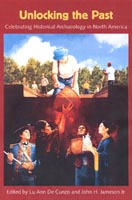Historical Archaeology that Matters Beyond Academics
Maria Franklin

I choose to practice historical archaeology because I can’t think of a more suitable, captivating, or innovative way to study people in the past than by considering the material remains they left behind. I’m probably guilty of giving more thought and energy to a pork dinner consumed some time in the late eighteenth-century than the family who prepared and ate it. And I’m certain that they would be mystified that anyone two centuries later would carefully excavate, record, and study--at great expense and with much labor--the butchered bones they tossed out. But studying the remains of meals discarded over a forty-year period by an enslaved community that once lived at Rich Neck plantation on the outskirts of Williamsburg, Virginia, has told us much about early Afro-Virginian life ways. Archaeological evidence indicates that community members hunted, fished, gardened, raised livestock, and collected shellfish, wild berries, and nuts for their families. They actively cultivated a unique foodways system that combined knowledge of West African, English, and Native American cultural practices. If you’ve ever had greens, black-eyed peas, or ham hocks, you’ve had a taste of the culinary ingenuity that enslaved Africans contributed to Southern foodways. Hence, through historical archaeology we have been able to write about a long-neglected part of American history--that involving enslaved African Americans--and to learn about how identity and culture are constructed and transformed within a matrix of complex social relationships.
In envisioning the future of historical archaeology, its potential to contribute new perspectives on history is great indeed. It is an important vehicle through which we can gain insights into a fuller spectrum of lived experiences in the past. This volume alone has contributions on subjects ranging from cultural exchange and identity, to labor and industry. As an interdisciplinary field, historical archaeology has the advantage of a wider body of evidence to research, informed by approaches from related disciplines. Martha Zierden’s essay on Charleston offers an example of an interdisciplinary archaeology. Further developments in geophysical surveying, Geographic Information Systems, and pollen, faunal, and botanical analyses will increasingly help historical archaeologists to tackle challenging questions about the past.
If we are to establish what issues are relevant to addressing the concerns of a diverse public, and to work towards bridging chasms that divide American society, future historical archaeology must emphasize community-based research. In theory, as John Triggs explains, the past belongs to us all, and we must take responsibility for ensuring that participation in studying and preserving it is shared broadly. If the present rise in programs like Alexandria Archaeology’s are any indication, community partnering and public education (particularly through the World Wide Web) will become routine. There is already strong advocacy within archaeology for both to become standard archaeological practice, which will hopefully help to boost support for the preservation of our cultural resources. Unfortunately, the vestiges of our heritage are increasingly destroyed at alarming rates, largely through development. We cannot hope to secure sites for future generations without your help.
About the Author:
Maria Franklin is an Assistant Professor with the Department of Anthropology and the Center for African and African American Studies at the University of Texas at Austin, and a Senior Research Fellow with the Department of Archaeological Research at The Colonial Williamsburg Foundation, Virginia.
